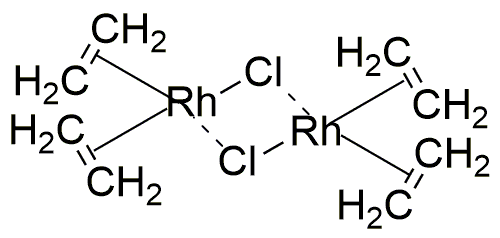Chlorobis(ethylene)rhodium(I) dimer is widely utilized in research focused on:
- Catalysis in Organic Synthesis: This compound serves as an efficient catalyst in various organic reactions, particularly in the formation of carbon-carbon bonds, making it invaluable in pharmaceutical and agrochemical industries.
- Hydrogenation Reactions: It is employed in hydrogenation processes to convert unsaturated compounds into saturated ones, which is crucial for producing fine chemicals and intermediates in the chemical industry.
- Polymerization Processes: The compound is used in the polymerization of olefins, contributing to the production of high-performance polymers that are essential in packaging, automotive, and construction sectors.
- Environmental Applications: It plays a role in catalyzing reactions that help in the degradation of pollutants, aiding in environmental remediation efforts.
- Research in Coordination Chemistry: This chemical is significant in academic research for studying coordination complexes, helping to advance the understanding of metal-ligand interactions.
General Information
Properties
Safety and Regulations
Applications
Chlorobis(ethylene)rhodium(I) dimer is widely utilized in research focused on:
- Catalysis in Organic Synthesis: This compound serves as an efficient catalyst in various organic reactions, particularly in the formation of carbon-carbon bonds, making it invaluable in pharmaceutical and agrochemical industries.
- Hydrogenation Reactions: It is employed in hydrogenation processes to convert unsaturated compounds into saturated ones, which is crucial for producing fine chemicals and intermediates in the chemical industry.
- Polymerization Processes: The compound is used in the polymerization of olefins, contributing to the production of high-performance polymers that are essential in packaging, automotive, and construction sectors.
- Environmental Applications: It plays a role in catalyzing reactions that help in the degradation of pollutants, aiding in environmental remediation efforts.
- Research in Coordination Chemistry: This chemical is significant in academic research for studying coordination complexes, helping to advance the understanding of metal-ligand interactions.
Documents
Safety Data Sheets (SDS)
The SDS provides comprehensive safety information on handling, storage, and disposal of the product.
Product Specification (PS)
The PS provides a comprehensive breakdown of the product’s properties, including chemical composition, physical state, purity, and storage requirements. It also details acceptable quality ranges and the product's intended applications.
Certificates of Analysis (COA)
Search for Certificates of Analysis (COA) by entering the products Lot Number. Lot and Batch Numbers can be found on a product’s label following the words ‘Lot’ or ‘Batch’.
Numéro de catalogue
Numéro de lot/série
Certificates Of Origin (COO)
This COO confirms the country where the product was manufactured, and also details the materials and components used in it and whether it is derived from natural, synthetic, or other specific sources. This certificate may be required for customs, trade, and regulatory compliance.
Numéro de catalogue
Numéro de lot/série
Safety Data Sheets (SDS)
The SDS provides comprehensive safety information on handling, storage, and disposal of the product.
DownloadProduct Specification (PS)
The PS provides a comprehensive breakdown of the product’s properties, including chemical composition, physical state, purity, and storage requirements. It also details acceptable quality ranges and the product's intended applications.
DownloadCertificates of Analysis (COA)
Search for Certificates of Analysis (COA) by entering the products Lot Number. Lot and Batch Numbers can be found on a product’s label following the words ‘Lot’ or ‘Batch’.
Numéro de catalogue
Numéro de lot/série
Certificates Of Origin (COO)
This COO confirms the country where the product was manufactured, and also details the materials and components used in it and whether it is derived from natural, synthetic, or other specific sources. This certificate may be required for customs, trade, and regulatory compliance.


